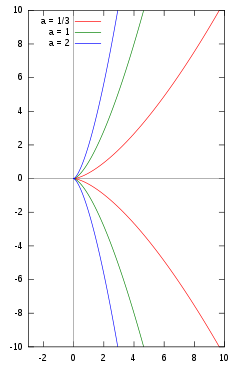Semicubical parabola

In mathematics, a cuspidal cubic or semicubical parabola is an algebraic plane curve defined parametrically as[1]
Its implicit equation is
which can be solved in y to yield the equation[1]
This cubic curve has a singular point at the origin, which is a cusp.
If one sets u = at, X = a2x, and Y = a3y, one gets
This implies that, for any value of a, the curve is homothetic to the curve for which a = 1, or, equivalently, that the curves corresponding to different values of a differ only by the choice of the unit length.
Properties
A special case of the semicubical parabola is the evolute of the parabola.[2] It has the equation
Expanding the Tschirnhausen cubic catacaustic shows that it is also a semicubical parabola:[3]
An additional defining property of the semicubical parabola is that it is an isochrone curve, meaning that a particle following its path while being pulled down by gravity travels equal vertical intervals in equal time periods. In this way it is related to the tautochrone curve, for which particles at different starting points always take equal time to reach the bottom, and the brachistochrone curve, the curve that minimizes the time it takes for a falling particle to travel from its start to its end.[4]
History
The semicubical parabola was discovered in 1657 by William Neile who computed its arc length. Although the lengths of some other non-algebraic curves including the logarithmic spiral and cycloid had already been computed (that is, those curves had been rectified), the semicubical parabola was the first algebraic curve (excluding the line and circle) to be rectified.[1]
The fact that this curve is the evolute of a parabola was discovered in 1659 by Christiaan Huygens; Huygens used this shape in 1664 to design a plate against which a clock pendulum could swing, causing its timing to be more regular than a free-swinging pendulum.[2]
The isochrone curve property of the semicubical parabola was published by James Bernoulli in 1690, answering a challenge posed in 1687 by Gottfried Wilhelm Leibniz.[4]
References
- ↑ 1.0 1.1 1.2 Pickover, Clifford A. (2009), "The Length of Neile's Semicubical Parabola", The Math Book: From Pythagoras to the 57th Dimension, 250 Milestones in the History of Mathematics, Sterling Publishing Company, Inc., p. 148, ISBN 9781402757969.
- ↑ 2.0 2.1 Yoder, Joella G. (2004), Unrolling Time: Christiaan Huygens and the Mathematization of Nature, Cambridge University Press, p. 88, ISBN 9780521524810.
- ↑ Weisstein, Eric W., "Tschirnhausen Cubic Catacaustic", MathWorld.
- ↑ 4.0 4.1 Carnahan, Walter H. (1947), "Time Curves", School Science and Mathematics 47 (6): 507–511, doi:10.1111/j.1949-8594.1947.tb06153.x.








